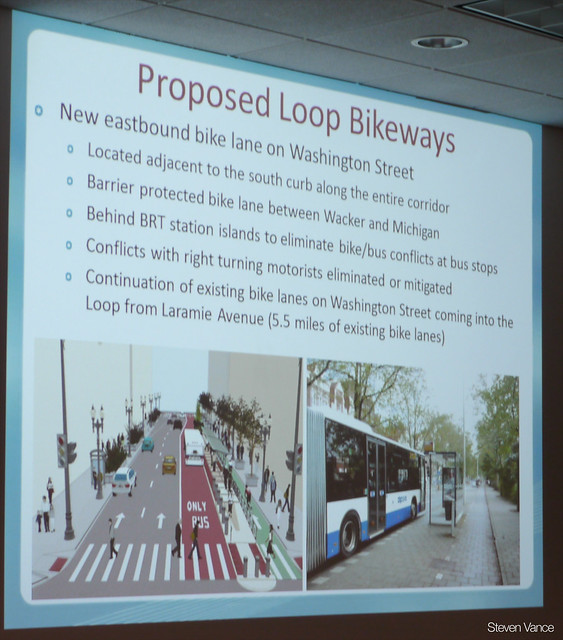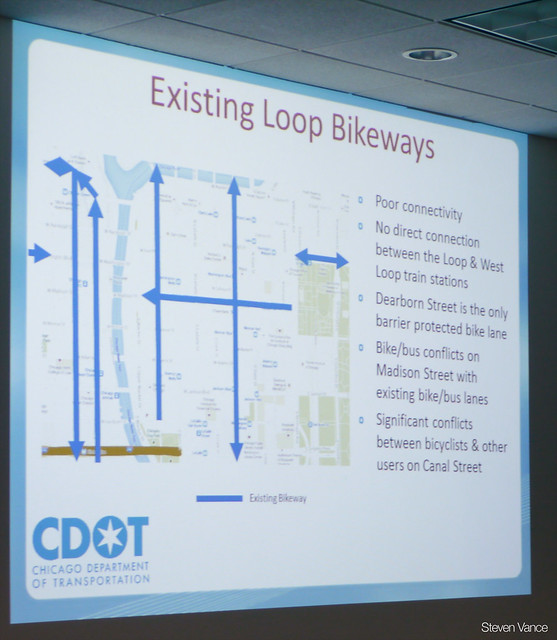Bicycle routes through the Loop suffer from "poor connectivity," admits Mike Amsden, assistant director of transportation planning at the Chicago Department of Transportation. At yesterday’s Mayor’s Bicycle Advisory Council meeting, Amsden revealed details about how the Central Loop BRT project will improve the situation by spring of 2015.
The Central Loop BRT project, Amsden said, will "move people more efficiently across the Loop," ending the days when it's faster to walk than take the bus across downtown, and also "optimize use of space, because most of it is devoted to cars" right now. Not only will buses get dedicated lanes, but so will bikes -- a sea change from present conditions, where, as Amsden says, "I’m ashamed to say we don’t have a network in the Loop."
By next year, new protected bike lanes will be added to Clinton Street, Washington Street, and Randolph Street.
- Clinton will have a two-way, protected bike lane from Fulton to Harrison. The lane, similar to Dearborn Street's, will be on the east curb, with direct access to Ogilvie Transportation Center and the Union Station Transit Center.
- Washington will have a one-way, protected bike lane from Wacker to Michigan. It will be protected from car traffic by parked cars on some blocks, and bus stop islands on others.
- Randolph will have a one-way, protected bike lane from Michigan to Clinton, separated from traffic by a parking lane. Amsden said they will be improving the existing bike lane on upper Randolph, but didn’t provide specifics.
We're awaiting more information from CDOT about how cyclists will cross on Washington and Randolph west of Wacker or Clinton, particularly to the bike lane along Desplaines through the West Loop.
Meanwhile, the existing bike lanes on Canal and Madison, the latter of which Amsden called "not the best example of a bike lane," will be removed.

Anne Alt, president of the Chicago Cycling Club and paralegal at FK Law Illinois (a Streetsblog sponsor), was relatively unfazed by the proposed switch-up. "Looking at the big picture, balancing the uses, and considering the overall nearby uses and the chaos factor" by Union Station, she said that "getting the bike lane out of [Canal] is a good thing... Making a two-way [bike lane on Clinton] should be a safer approach." She said that Washington and Randolph are a little out of the way for her trips, "but those streets make sense" as an alternative to Madison going west and, well, nothing going east.
To connect people bicycling eastbound on Washington to the existing bike lane on Randolph, which leads to the Millennium Park bike station and the Lakefront Trail, CDOT will add a one-block bike lane northbound on Michigan Avenue. When asked about how bicyclists will make the tricky left turn from Washington onto Michigan, Amsden said the intersection was still being designed.
Amsden explained that removing the bike lane from Canal would clear up significant conflicts between bicyclists, taxis, and both CTA and intercity buses. Streetsblog asked how people will bicycle to destinations on Canal and Madison. Amsden replied, "People can bike on all streets, and we believe these better bike facilities are [being installed] so they can spend the least amount of time on those [other] streets," adding that the new bus and bike facilities will "calm traffic much more than today."





